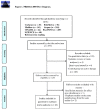Efficacy of eye-movement desensitization and reprocessing for patients with posttraumatic-stress disorder: a meta-analysis of randomized controlled trials
- PMID: 25101684
- PMCID: PMC4125321
- DOI: 10.1371/journal.pone.0103676
Efficacy of eye-movement desensitization and reprocessing for patients with posttraumatic-stress disorder: a meta-analysis of randomized controlled trials
Abstract
Background: We performed the first meta-analysis of clinical studies by investigating the effects of eye-movement desensitization and reprocessing (EMDR) therapy on the symptoms of posttraumatic stress disorder (PTSD), depression, anxiety, and subjective distress in PTSD patients treated during the past 2 decades.
Methods: We performed a quantitative meta-analysis on the findings of 26 randomized controlled trials of EMDR therapy for PTSD published between 1991 and 2013, which were identified through the ISI Web of Science, Embase, Cochrane Library, MEDLINE, PubMed, Scopus, PsycINFO, and the Cumulative Index to Nursing and Allied Health Literature electronic databases, among which 22, 20, 16, and 11 of the studies assessed the effects of EMDR on the symptoms of PTSD, depression, anxiety, and subjective distress, respectively, as the primary clinical outcome.
Results: The meta-analysis revealed that the EMDR treatments significantly reduced the symptoms of PTSD (g = -0.662; 95% confidence interval (CI): -0.887 to -0.436), depression (g = -0.643; 95% CI: -0.864 to -0.422), anxiety (g = -0.640; 95% CI: -0.890 to -0.390), and subjective distress (g = -0.956; 95% CI: -1.388 to -0.525) in PTSD patients.
Conclusion: This study confirmed that EMDR therapy significantly reduces the symptoms of PTSD, depression, anxiety, and subjective distress in PTSD patients. The subgroup analysis indicated that a treatment duration of more than 60 min per session was a major contributing factor in the amelioration of anxiety and depression, and that a therapist with experience in conducting PTSD group therapy was a major contributing factor in the reduction of PTSD symptoms.
Conflict of interest statement
Figures





Similar articles
-
Eye movement desensitization and reprocessing (EMDR) therapy for posttraumatic stress disorder in adults with serious mental illness within forensic and rehabilitation services: a study protocol for a randomized controlled trial.Trials. 2019 Nov 21;20(1):642. doi: 10.1186/s13063-019-3760-2. Trials. 2019. PMID: 31753032 Free PMC article.
-
Exploration of eye movement desensitization and reprocessing in treating posttraumatic stress-disorder in patients with acquired brain injury: a retrospective case series.Eur J Psychotraumatol. 2023;14(2):2264117. doi: 10.1080/20008066.2023.2264117. Epub 2023 Oct 20. Eur J Psychotraumatol. 2023. PMID: 37860867 Free PMC article.
-
The effectiveness of eye movement desensitization and reprocessing toward anxiety disorder: A meta-analysis of randomized controlled trials.J Psychiatr Res. 2020 Apr;123:102-113. doi: 10.1016/j.jpsychires.2020.01.005. Epub 2020 Jan 28. J Psychiatr Res. 2020. PMID: 32058073 Review.
-
Comparison of eye movement desensitization and reprocessing therapy, cognitive behavioral writing therapy, and wait-list in pediatric posttraumatic stress disorder following single-incident trauma: a multicenter randomized clinical trial.J Child Psychol Psychiatry. 2017 Nov;58(11):1219-1228. doi: 10.1111/jcpp.12768. Epub 2017 Jun 28. J Child Psychol Psychiatry. 2017. PMID: 28660669 Clinical Trial.
-
25 years of Eye Movement Desensitization and Reprocessing (EMDR): The EMDR therapy protocol, hypotheses of its mechanism of action and a systematic review of its efficacy in the treatment of post-traumatic stress disorder.Rev Psiquiatr Salud Ment (Engl Ed). 2018 Apr-Jun;11(2):101-114. doi: 10.1016/j.rpsm.2015.12.002. Epub 2016 Feb 11. Rev Psiquiatr Salud Ment (Engl Ed). 2018. PMID: 26877093 Review. English, Spanish.
Cited by
-
Effectiveness of treating depression with eye movement desensitization and reprocessing among inpatients-A follow-up study over 12 months.Front Psychol. 2022 Aug 10;13:937204. doi: 10.3389/fpsyg.2022.937204. eCollection 2022. Front Psychol. 2022. PMID: 36033012 Free PMC article.
-
Apples and oranges: PTSD patients and healthy individuals are not comparable in their subjective and physiological responding to emotion induction and bilateral stimulation.Front Psychol. 2024 Jun 12;15:1406180. doi: 10.3389/fpsyg.2024.1406180. eCollection 2024. Front Psychol. 2024. PMID: 38933577 Free PMC article.
-
Effectiveness of time-limited eye movement desensitization reprocessing therapy for parents of children with a rare life-limiting illness: a randomized clinical trial.Orphanet J Rare Dis. 2022 Sep 2;17(1):328. doi: 10.1186/s13023-022-02500-9. Orphanet J Rare Dis. 2022. PMID: 36056362 Free PMC article. Clinical Trial.
-
Posttraumatic growth-oriented peer-based training among U.S. veterans: evaluation of post-intervention and long-term follow-up outcomes.Front Psychol. 2024 Jan 5;14:1322837. doi: 10.3389/fpsyg.2023.1322837. eCollection 2023. Front Psychol. 2024. PMID: 38250126 Free PMC article.
-
Eye movement desensitization and reprocessing (EMDR) in children and adolescents with subthreshold PTSD after medically related trauma: design of a randomized controlled trial.Eur J Psychotraumatol. 2018 Nov 22;9(1):1536287. doi: 10.1080/20008198.2018.1536287. eCollection 2018. Eur J Psychotraumatol. 2018. PMID: 30510642 Free PMC article.
References
-
- Shapiro F, Solomon RM (1995) Eye movement desensitization and reprocessing: Wiley Online Library.
-
- Shapiro F (2001) Eye movement desensitization and reprocessing: Basic principles, protocols, and procedures, 2nd ed. New York: The Guilford Press.
-
- Davidson PR, Parker KC (2001) Eye movement desensitization and reprocessing (EMDR): a meta-analysis. J Consult Clin Psychol 69: 305–316. - PubMed
-
- Rodenburg R, Benjamin A, de Roos C, Meijer AM, Stams GJ (2009) Efficacy of EMDR in children: a meta-analysis. Clin Psychol Rev 29: 599–606. - PubMed
-
- Hogberg G, Pagani M, Sundin O, Soares J, Aberg-Wistedt A, et al. (2007) On treatment with eye movement desensitization and reprocessing of chronic posttraumatic stress disorder in public transportation workers—a randomized controlled trial. Nord J Psychiatry 61: 54–61. - PubMed
Publication types
MeSH terms
LinkOut - more resources
Full Text Sources
Other Literature Sources
Medical
Miscellaneous

